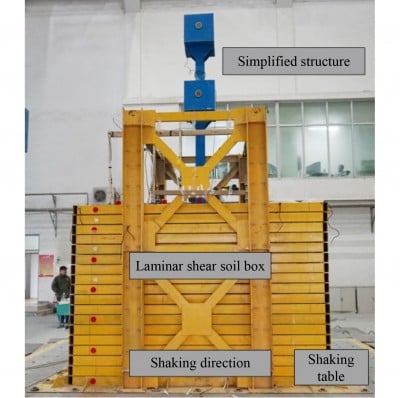Pile foundations are widely used in supporting bridges, high-rise buildings, and offshore structures due to their strong adaptability to complex geological conditions and excellent load-bearing performance. However, in liquefiable sites, saturated sand liquefaction caused by earthquake loading often leads to serious damage to pile structures, such as reduced bearing capacity, excessive deformation, and even structural collapse. The seismic response of soil−pile−structure systems in liquefiable sites is highly complex, and existing studies often focus on macroscopic liquefaction phenomena or overall seismic response laws, while the assessment of the dynamic interaction and failure mechanism of end-bearing friction piles, especially the impact of articulated connections between pile tops and caps, remains insufficient.
Therefore, researchers from the Department of Hydraulic Engineering of Tsinghua University and the Key Laboratory of Urban Security and Disaster Engineering of the Ministry of Education of Beijing University of Technology have jointly carried out a research entitled “Numerical Analysis on Seismic Response and Failure Mechanism of Articulated Pile−Structure System in a Liquefiable Site from Shaking-Table Experiments”.
This study combines numerical simulation with shaking-table test results of a soil−pile−structure dynamic system to investigate the seismic response and failure mode of an articulated pile−structure system in a liquefiable site. A three-dimensional finite-difference numerical model was established using FLAC3D software, in which the SANISAND constitutive model was adopted to simulate the liquefaction behavior of saturated sand, and the articulated connection between pile tops and caps, as well as the friction and end-bearing characteristics of piles, were accurately simulated. The rationality of the numerical model was verified by comparing the pore-water pressure response, soil and pile acceleration response, dynamic shear-stress–shear-strain relationship, and pile shaft bending moment with the shaking-table test results. The research results show that the numerical simulation results are in good agreement with the experimental data. Under earthquake loading, the pore-water pressure ratio of saturated sand increases rapidly, leading to soil liquefaction; the acceleration of soil and piles is not significantly amplified in the saturated sand layer but shows an amplification trend in the upper part; the slopes of the dynamic shear-stress–shear-strain hysteretic curves of soil at different positions decrease, indicating a reduction in soil shear strength. The maximum bending moments of the pile shaft appear in the middle and lower parts, while the shear forces at the corresponding positions are small. From the deformation mode of the pile-group foundation, when the connection between the pile top and cap is articulated, the pile shaft is prone to typical bending failure due to excessive bending moment in the middle part, which requires sufficient attention in engineering practice.
The paper “Numerical Analysis on Seismic Response and Failure Mechanism of Articulated Pile−Structure System in a Liquefiable Site from Shaking-Table Experiments” is authored by Pengfei DOU, Hao LIU, Chengshun XU, Jinting WANG, Yilong SUN, and Xiuli DU. It is published in Front. Struct. Civ. Eng. 2024, 18(7): 1117–1133, with the DOI: https://doi.org/10.1007/s11709-024-0958-5. Chengshun XU is the corresponding author, and the E-mail is xuchengshun@bjut.edu.cn. © Higher Education Press 2024.
